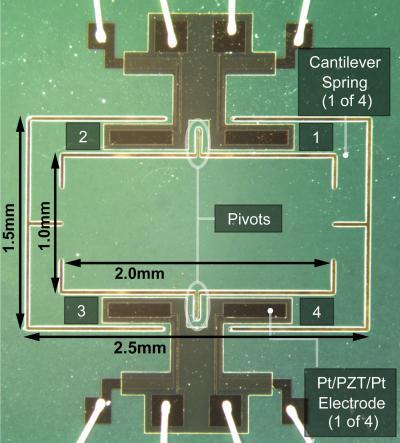When it comes to animals with good hearing, flies might not be the first one you'd think of. The Ormia ochracea fly, however, has a unique hearing mechanism that allows it to precisely determine the location of a cricket based on its chirps ... it then deposits its larvae on the cricket, which ultimately consume the poor insect. Scientists at the University of Texas Austin have now duplicated that mechanism, with hopes that it could find use in applications such as next-generation hearing aids.
In the case of larger animals such as humans, the brain is able to ascertain the source of a sound based on the split-second delay between its being detected by the left and right ears. Insects, on the other hand, are so tiny that sounds register on both sides of their body almost simultaneously. Although they're still able to "hear" by sensing vibrations made by sounds, they generally can't tell where those sounds are coming from.
Ormia ochracea is different from other insects, however, in that it has a miniscule seesaw-like structure in the sub-2-mm space between its ears. Even in the four millionths of a second that it takes for a sound to pass through that space, it still causes the structure to vibrate, plus the sound undergoes a slight phase shift.
Like a full-size seesaw (or teeter-totter, if you prefer), any movements the structure makes are amplified by the fact that its two ends simultaneously move in opposite directions. This means that the phase shift will cause one side of the mechanism to dip noticeably lower than the other, thus letting the fly know the sound's direction of travel. According to UT Austin's assistant professor Neal Hall, it's roughly equivalent to a person being able to locate the direction of the epicenter of an earthquake, by analyzing the delay between the tremors being felt by their left and right feet.

Hall and his team built a similar structure (seen above) that incorporates a flexible silicon beam suspended on two pivots. Integrated piezoelectric materials in four sensing ports convert mechanical strain in that beam into electrical pulses, allowing the device to simultaneously measure both the amount and direction of sound-induced flexing.
Additionally, at 2.5 mm, the device is only about one millimeter longer than its natural counterpart.
The scientists hope that once developed further, the technology could be used in compact low-power hearing aids that are are better able to discern conversations from background noise, along with possible military applications.
A paper on the research was recently published in the journal Applied Physics Letters.
Sources: American Institute of Physics, University of Texas Austin





